Strength and Durability of Cement-Treated Lateritic Soil
Abstract
:1. Introduction
2. Materials and Methods
3. Results and Discussion
3.1. Compaction
3.2. Unconfined Compressive Strength
3.3. Effect of Curing Time on Cement Stabilized Laterite
3.4. Effect of Cement Content on Soil Stiffness
3.5. Durability
3.6. Microstructure Analysis
4. Conclusions
- The maximum dry density (MDD) and optimum moisture content (OMC) of lateritic soil increase with cement content.
- The unconfined compressive strength of lateritic soil increases with cement percentage and curing time.
- Considering Malaysia Public Works Department (PWD) standards, 6% cement cured in 7 days was found sufficient to obtain a UCS of more than 800 kPa for low-volume road construction.
- The strength development index (SDI) equals 2.99 based on the unconfined compressive strength (UCS = 200.74 kPa) of untreated lateritic soil and the MPWD’s threshold value (UCS = 800 kPa).
- The elastic modulus of lateritic soil increased with cement content, indicating that lateritic soil’s ductility decreased with increasing cement content. Furthermore, an equation was proposed for E50 according to unconfined compressive strength results;
- The durability results revealed that the lateritic soil treated with 3% cement entirely collapsed after one wetting–drying cycle. On the contrary, the specimens treated with 6% cement withstood against 15 WD cycles. However, the UCS of 6% cement-treated specimens decreased against WD cycles, but at the end of the 15th cycle, the UCS result was more than 800 kPa. On the other hand, the UCS results exhibited an increasing trend against WD for 9% and 12% cement-treated lateritic specimens, indicating long-term pozzolanic reactions.
- The microstructure analysis depicted that the CSH, CAH, and CASH were produced because of the pozzolanic reaction between alumina–silica of the soil and calcium ions of the cement or lime in the presence of water. Subsequently, the pore and crack size decreased with an increase in cement content, indicating increasing mechanical properties.
Author Contributions
Funding
Institutional Review Board Statement
Informed Consent Statement
Data Availability Statement
Acknowledgments
Conflicts of Interest
References
- Razali, R.; Che Malek, M.S. The usage of cement for soil stabilisation in construction of low volume roads in Malaysia. IOP Conf. Ser. Mater. Sci. Eng. 2019, 512. [Google Scholar] [CrossRef]
- Rashid, A.S.A.; Kalatehjari, R.; Noor, N.M.; Yaacob, H.; Moayedi, H.; Sing, L.K. Relationship between liquidity index and stabilized strength of local subgrade materials in a tropical area. Meas. J. Int. Meas. Confed. 2014, 55, 231–237. [Google Scholar] [CrossRef]
- Lacroix, A. Les Latérites de Guinée et les produits d’altération qui leur sont assocés. [The Laterites of Guinea and the Products of Al-teration Associated with Them.]. Nouv. Arch. Artic. du Muséum D’Histoire Nat. Paris Fr. 1913, 255–356. [Google Scholar]
- Martin, F.J.; Doyne, H.C. Laterite and Lateritic Soils in Sierra Leone, 1. J. Agric. Sci. 1927, 17, 530–546. [Google Scholar] [CrossRef]
- Martin, F.J.; Doyne, H.C. Laterite and Lateritic Soils in Sierra Leone, 2. J. Agric. Sci. 1930, 20, 135–143. [Google Scholar] [CrossRef]
- Klohn, E.J. Laterite Soil Engineering, Pedogenesis and Engineering Principles: Book Review. Can. Geotech. J. 1977, 14, 442–444. [Google Scholar] [CrossRef]
- Caro, S.; Agudelo, J.P.; Caicedo, B.; Orozco, L.F.; Patiño, F.; Rodado, N. Advanced characterisation of cement-stabilised lateritic soils to be used as road materials. Int. J. Pavement Eng. 2018, 20, 1425–1434. [Google Scholar] [CrossRef]
- Cecchin, I.; Reddy, K.R.; Thomé, A.; Tessaro, E.F.; Schnaid, F. Nanobioremediation: Integration of nanoparticles and bioremediation for sustainable remediation of chlorinated organic contaminants in soils. Int. Biodeterior. Biodegrad. 2017, 119, 419–428. [Google Scholar] [CrossRef]
- Safuan, A.; Rashid, A.; Irfan, M.; Horpibulsuk, S.; Azril, M.; Zurairahetty, N.; Yunus, M.; Borhamdin, S. Development of sustainable masonry units from flood mud soil: Strength and morphology investigations. Constr. Build. Mater. 2016. [Google Scholar] [CrossRef]
- Lati, N.; Safuan, A.; Rashid, A.; Siddiqua, S.; Horpibulsuk, S. Micro-structural analysis of strength development in low- and high swelling clays stabilized with magnesium chloride solution—A green soil stabilizer. Appl. Clay Sci. 2015, 118, 195–206. [Google Scholar] [CrossRef]
- Yaowarat, T.; Horpibulsuk, S.; Arulrajah, A.; Maghool, F.; Mirzababaei, M.; Rashid, A.S.A.; Chinkulkijniwat, A. Cement stabilisation of recycled concrete aggregate modified with polyvinyl alcohol. Int. J. Pavement Eng. 2020, 1–9. [Google Scholar] [CrossRef]
- Rashid, A.S.A.; Black, J.A.; Mohamad, H.; Noor, N.M. Marine Georesources & Geotechnology Behavior of Weak Soils Reinforced with End-Bearing Soil-Cement Columns Formed by the Deep Mixing Method. Mar. Georesour. Geotechnol. 2014, 37–41. [Google Scholar] [CrossRef]
- Sudla, P.; Donrak, J.; Ph, D.; Hoy, M.; Ph, D.; Horpibulsuk, S.; Ph, D.; Arulrajah, A.; Ph, D.; Rashid, A.S.A.; et al. Laboratory Investigation of Cement-Stabilized Marginal Lateritic Soil by Crushed Slag—Fly Ash Replacement for Pavement Applications. J. Mater. Civ. Eng. 2020, 32, 1–11. [Google Scholar] [CrossRef]
- Latifi, N.; Asce, M.; Vahedifard, F.; Asce, M.; Ghazanfari, E.; Asce, M.; Rashid, A.S.A. Sustainable Usage of Calcium Carbide Residue for Stabilization of Clays. J. Mater. Civ. Eng. 2018, 30, 1–10. [Google Scholar] [CrossRef]
- Yaowarat, T.; Horpibulsuk, S.; Ph, D.; Arulrajah, A.; Ph, D.; Mirzababaei, M.; Ph, D.; Rashid, A.S.A. Compressive and Flexural Strength of Polyvinyl Alcohol—Modified Pavement Concrete Using Recycled Concrete Aggregates. J. Mater. Civ. Eng. 2018, 30, 1–8. [Google Scholar] [CrossRef]
- Latifi, N.; Marto, A.; Safuan, A.; Jacky, A.R.; Jia, L. Strength and Physico-chemical Characteristics of Fly Ash—Bottom Ash Mixture. Arab. J. Sci. Eng. 2015, 40, 2447–2455. [Google Scholar] [CrossRef]
- Latifi, N.; Horpibulsuk, S.; Meehan, C.L. Xanthan gum biopolymer: An eco-friendly additive for stabilization of tropical organic peat. Environ. Earth Sci. 2016, 2–11. [Google Scholar] [CrossRef]
- Latifi, N.; Safuan, A.; Aminaton, A.R.; Mahmood, M. Effect of magnesium chloride solution on the physico-chemical characteristics of tropical peat. Environ. Earth Sci. 2016, 75, 1–9. [Google Scholar] [CrossRef]
- Latifi, N.; Rashid, A.S.A.; Ecemis, N.; Tahir, M. Time-dependent physicochemical characteristics of Malaysian residual soil stabilized with magnesium chloride solution. Arab. J. Geosci. 2015, 2, 1–12. [Google Scholar] [CrossRef] [Green Version]
- Safuan, A.; Seyedali, A.R.; Suksun, T. Shear Strength Improvement of Lateritic Soil Stabilized by Biopolymer Based Stabilizer. Geotech. Geol. Eng. 2019, 8. [Google Scholar] [CrossRef]
- Anuar, K.; Ahmad, K.; Rashid, S.A.; Hong, A.; Chong, K.; Yah, S. Criteria of Acceptance for Constant Rate of Strain Consolidation Test for Tropical Cohesive Soil. Geotech. Geol. Eng. 2016, 34, 931–947. [Google Scholar] [CrossRef]
- Hasmida, W.; Hassan, W.; Rashid, A.S.A.; Latifi, N.; Horpibulsuk, S.; Borhamdin, S. Strength and morphological characteristics of organic soil stabilized with magnesium chloride. Q. J. Eng. Geol. Hydrogeol. 2017, 50, 454–459. [Google Scholar]
- Rashid, A.S.A. Behaviour of soft soil improved by floating soil–cement columns. Int. J. Phys. Model. Geotech. 2018, 18, 95–116. [Google Scholar] [CrossRef]
- Changjutturas, K. Solidification and stabilisation of metal plating sludge with fly ash geopolymers. Environ. Geotech. 2019, 40, 1–10. [Google Scholar] [CrossRef]
- Zainuddin, N.; Zurairahetty, N.; Yunus, M.; Al-bared, M.A.M.; Marto, A.; Sati, I.; Harahap, H.; Rashid, A.S.A. Measuring the Engineering Properties of Marine Clay Treated with Disposed Granite Waste. Measurement 2018, 131, 50–60. [Google Scholar] [CrossRef]
- Bunawan, A.R.; Momeni, E.; Armaghani, D.J.; Nissa, K.; Rashid, A.S.A. Neuro-Fuzzy and Neural Network Techniques to Estimate Bearing Capacity of Cohesive Soft Soils Reinforced with Soil-Cement Columns. Measurement 2018. [Google Scholar] [CrossRef]
- Latifi, N.; Rashid, A.S.A.; Siddiqua, S.; Zaimi, M.; Majid, A. Strength Measurement and Textural Characteristics of Tropical Residual Soil Stabilised with Liquid Polymer. Measurement 2016. [Google Scholar] [CrossRef]
- Rashid, A.S.A.; Black, J.A.; Kueh, A.H. Behaviour of Weak Soils Reinforced With Soil Cement Columns Formed by the Deep Mixing Method: Rigid and Flexible Footings. Measurement 2015. [Google Scholar] [CrossRef]
- Raftari, M.; Rashid, A.S.A.; Kassim, K.A.; Moayedi, H. Evaluation of kaolin slurry properties treated with cement. Measurement 2014, 50, 222–228. [Google Scholar] [CrossRef]
- Wahab, N.A.; Rashid, A.S.A.; Roshan, M.J.; Rizal, N.H.A.; Yunus, N.Z.M.; Hezmi, M.A.; Tadza, M.Y.M. Effects of Cement on the Compaction Properties of Lateritic Soil. IOP Conf. Ser. Mater. Sci. Eng. 2021, 1–7. [Google Scholar] [CrossRef]
- Roshan, M.J.; Rashid, A.S.A.; Wahab, N.A.; Hezmi, M.A.; Jusoh, S.N.; Azmi, M. Stability of Railway Embankment in Saturated and Unsaturated Conditions. IOP Conf. Ser. Mater. Sci. Eng. 2021, 1–14. [Google Scholar] [CrossRef]
- Rashid, A.S.A.; Latifi, N.; Meehan, C.L.; Manahiloh, K.N. Sustainable Improvement of Tropical Residual Soil Using an Environmentally Friendly Additive. Geotech. Geol. Eng. 2017, 35, 2613–2623. [Google Scholar] [CrossRef]
- de Carvalho, J.C.; de Rezende, L.R.; Cardoso, F.B.D.F.; de FL Lucena, L.C.; Guimarães, R.C.; Valencia, Y.G. Tropical soils for highway construction: Peculiarities and considerations. Transp. Geotech. 2015, 5, 3–19. [Google Scholar] [CrossRef]
- Sharma, M.; Satyam, N.; Reddy, K.R. State of the art review of emerging and biogeotechnical methods for liquefaction mitigation in sands. J. Hazardous, Toxic Radioact. Waste 2021, 25. [Google Scholar] [CrossRef]
- Nafisi, A.; Montoya, B.M.; Evans, T.M. Shear strength envelopes of biocemented sands with varying particle size and cementation level. J. Geotech. Geoenviron. Eng. 2020, 146. [Google Scholar] [CrossRef]
- Ng, W.; Lee, M.; Hii, S. An Overview of the Factors Affecting Microbial-Induced Calcite Precipitation and its Potential Application in Soil Improvement. World Acad. Sci. Eng. Technol. 2012, 6, 723–729. [Google Scholar]
- Sharma, A.; Ramkrishnan, R. Study on effect of Microbial Induced Calcite Precipitates on strength of fine grained soils. Perspect. Sci. 2016, 8, 198–202. [Google Scholar] [CrossRef] [Green Version]
- Hasriana, L.S.; Djide, M.N.; Harianto, T. A study on clay soil improvement with Bacillus subtilis bacteria as the road subbase layer. Int. J. GEOMATE 2018, 15, 114–120. [Google Scholar] [CrossRef]
- Islam, M.T.; Chittoori, B.C.S.; Burbank, M. Evaluating the applicability of biostimulated calcium carbonate precipitation to stabilize clayey soils. J. Mater. Civ. Eng. 2020, 32, 1–11. [Google Scholar] [CrossRef]
- Osinubi, K.J.; Eberemu, A.O.; Ijimdiya, T.S.; Yakubu, S.E.; Sani, J.E. Potential Use Of B. Pumilus In Microbial- Induced Calcite Precipitation Improvement of Lateritic Soil. In Proceedings of the 2nd Symposium on Coupled Phenomena in Environmental Geotechnics (CPEG2), Leeds, UK, 6–7 September 2017. [Google Scholar]
- Behzadipour, H.; Ghezelbash, G.R.; Pakbaz, M.S. Effects of biocementation on strength parameters of silty and clayey sands. Bioinspired, Biomim. Nanobiomater. 2019, 9, 24–32. [Google Scholar] [CrossRef]
- Choi, S.G.; Chu, J.; Brown, R.C.; Wang, K.; Wen, Z. Sustainable Biocement Production via Microbially Induced Calcium Carbonate Precipitation: Use of Limestone and Acetic Acid Derived from Pyrolysis of Lignocellulosic Biomass. ACS Sustain. Chem. Eng. 2017, 5, 5183–5190. [Google Scholar] [CrossRef]
- Rahman, M.M.; Hora, R.N.; Ahenkorah, I.; Beecham, S.; Karim, M.R.; Iqbal, A. State-of-the-art review of microbial-induced calcite precipitation and its sustainability in engineering applications. Sustainability 2020, 12, 6281. [Google Scholar] [CrossRef]
- Zango, M.U.; Kassim, K.A.; Sa’ari, R.; Rashid, M.F.A.; Muhammed, A.S.; Ahmad, K.; Makinda, J. Use of digital image technique to study leachate penetration in biocemented residual soil. Mater. Today Proc. 2021. [Google Scholar] [CrossRef]
- Yuan, H.; Ren, G.; Liu, K.; Zheng, W.; Zhao, Z. Experimental study of EICP combined with organic materials for silt improvement in the yellow river flood area. Appl. Sci. 2020, 10, 7678. [Google Scholar] [CrossRef]
- Javadi, N.; Khodadadi, H.; Hamdan, N.; Kavazanjian, E. EICP treatment of soil by using Urease enzyme extracted from watermelon seeds. In Proceedings of the IFC, Orlando, FL, USA, 5–10 March 2018; pp. 115–124. [Google Scholar]
- Latifi, N.; Eisazadeh, A.; Marto, A. Strength behavior and microstructural characteristics of tropical laterite soil treated with sodium silicate-based liquid stabilizer. Environ. Earth Sci. 2014, 72, 91–98. [Google Scholar] [CrossRef]
- Consoli, N.C.; Bittar Marin, E.J.; Quiñónez Samaniego, R.A.; Heineck, K.S.; Johann, A.D.R. Use of Sustainable Binders in Soil Stabilization. J. Mater. Civ. Eng. 2019, 31, 06018023. [Google Scholar] [CrossRef]
- Oyediran, I.A.; Okosun, J. An attempt to improve geotechnical properties of some highway lateritic soils with lime. RMZ–M&G 2013, 60, 287–296. [Google Scholar]
- Jiang, N.J.; Du, Y.J.; Liu, S.Y.; Wei, M.L.; Horpibulsuk, S.; Arulrajah, A. Multi-scale laboratory evaluation of the physical, mechanical, and microstructural properties of soft highway subgrade soil stabilized with calcium carbide residue. Can. Geotech. J. 2016, 53, 373–383. [Google Scholar] [CrossRef] [Green Version]
- Kampala, A.; Horpibulsuk, S.; Prongmanee, N.; Chinkulkijniwat, A. Influence of wet-dry cycles on compressive strength of calcium carbide residue–fly ash stabilized clay. J. Mater. Civ. Eng. 2014, 26, 633–643. [Google Scholar] [CrossRef]
- Du, Y.J.; Jiang, N.J.; Liu, S.Y.; Horpibulsuk, S.; Arulrajah, A. Field evaluation of soft highway subgrade soil stabilized with calcium carbide residue. Soils Found. 2016, 56, 301–314. [Google Scholar] [CrossRef]
- Phummiphan, I.; Horpibulsuk, S.; Rachan, R.; Arulrajah, A.; Shen, S.L.; Chindaprasirt, P. High calcium fly ash geopolymer stabilized lateritic soil and granulated blast furnace slag blends as a pavement base material. J. Hazard. Mater. 2018, 341, 257–267. [Google Scholar] [CrossRef] [PubMed]
- Phummiphan, I.; Horpibulsuk, S.; Sukmak, P.; Chinkulkijniwat, A.; Arulrajah, A.; Shen, S.L. Stabilisation of marginal lateritic soil using high calcium fly ash-based geopolymer. Road Mater. Pavement Des. 2016, 17, 877–891. [Google Scholar] [CrossRef]
- Busari, A.; Oyedepo, J.; Ofuyatan, O.; Nurain, S.; Ajayi, S.; Oti, M.N. Sustainability in Road Construction: Using Bamboo Straw Ash To Improve the Index Properties of Lateritic Soil. Eur. J. Sustain. Dev. 2018, 7, 89–97. [Google Scholar] [CrossRef]
- Ibrahim, N.A.; A RASHID, A.S.; Mohd Yunus, N.Z.; Latifi, N.; Horpibulsuk, S. Sustainable Use of Stabilized Flood Mud As Subgrade Soil for Low Volume Traffic Roads. Sci. Iran. 2020, 27, 2719–2726. [Google Scholar] [CrossRef] [Green Version]
- Latifi, N.; Eisazadeh, A.; Marto, A.; Meehan, C.L. Tropical residual soil stabilization: A powder form material for increasing soil strength. Constr. Build. Mater. 2017, 147, 827–836. [Google Scholar] [CrossRef]
- Rosa, M.G.; Cetin, B.; Edil, T.B.; Benson, C.H. Freeze–Thaw Performance of Fly Ash–Stabilized Materials and Recycled Pavement Materials. J. Mater. Civ. Eng. 2017, 29, 04017015. [Google Scholar] [CrossRef]
- Mohajerani, A.; Ashdown, M.; Abdihashi, L.; Nazem, M. Expanded polystyrene geofoam in pavement construction. Constr. Build. Mater. 2017, 157, 438–448. [Google Scholar] [CrossRef]
- Zolfeghari Far, S.Y.; Kassim, K.A.; Eisazadeh, A.; Khari, M. An evaluation of the tropical soils subjected physicochemical stabilization for remote rural roads. Procedia Eng. 2013, 54, 817–826. [Google Scholar]
- Horpibulsuk, S.; Suksiripattanapong, C.; Samingthong, W.; Rachan, R.; Arulrajah, A. Durability against Wetting–Drying Cycles of Water Treatment Sludge–Fly Ash Geopolymer and Water Treatment Sludge–Cement and Silty Clay–Cement Systems. J. Mater. Civ. Eng. 2016, 28, 04015078. [Google Scholar] [CrossRef]
- Mohammadinia, A.; Arulrajah, A.; Sanjayan, J.; Disfani, M.M.; Bo, M.W.; Darmawan, S. Laboratory Evaluation of the Use of Cement-Treated Construction and Demolition Materials in Pavement Base and Subbase Applications. J. Mater. Civ. Eng. 2015, 27, 04014186. [Google Scholar] [CrossRef]
- Du, Y.; Wei, M.; Reddy, K.R.; Jin, F. Compressibility of cement-stabilized zinc-contaminated high plasticity clay. Nat Hazards 2014, 73, 671–683. [Google Scholar] [CrossRef]
- Ho, M.H.; Chan, C.M. Some mechanical properties of cement stabilized malaysian soft clay. World Acad. Sci. Eng. Technol. 2011, 74, 24–31. [Google Scholar] [CrossRef]
- Horpibulsuk, S.; Liu, M.D.; Liyanapathirana, D.S.; Suebsuk, J. Behaviour of cemented clay simulated via the theoretical framework of the Structured Cam Clay model. Comput. Geotech. 2010, 37, 1–9. [Google Scholar] [CrossRef]
- Horpibulsuk, S.; Miura, N.; Nagaraj, T.S. Clay–Water/Cement Ratio Identity for Cement Admixed Soft Clays. J. Geotech. Geoenviron. Eng. 2005, 131, 187–192. [Google Scholar] [CrossRef]
- Horpibulsuk, S.; Miura, N.; Bergado, D.T. Undrained Shear Behavior of Cement Admixed Clay at High Water Content. J. Geotech. Geoenviron. Eng. 2004, 130, 1096–1105. [Google Scholar] [CrossRef]
- Tremblay, H.; Duchesne, J.; Locat, J.; Leroueil, S. Influence of the nature of organic compounds on fine soil stabilization with cement. Can. Geotech. J. 2002, 39, 535–546. [Google Scholar] [CrossRef]
- Mengue, E.; Mroueh, H.; Lancelot, L.; Medjo Eko, R. Design and parametric study of a pavement foundation layer made of cement-treated fine-grained lateritic soil. Soils Found. 2018, 58, 666–677. [Google Scholar] [CrossRef]
- Nusit, K.; Jitsangiam, P.; Kodikara, J.; Bui, H.H.; Leung, G.L.M. Advanced characteristics of cement-treated materials with respect to strength performance and damage evolution. J. Mater. Civ. Eng. 2017, 29, 04016255. [Google Scholar] [CrossRef]
- Du, Y.J.; Jiang, N.J.; Liu, S.Y.; Jin, F.; Singh, D.N.; Puppala, A.J. Engineering properties and microstructural characteristics of cement-stabilized zinc-contaminated kaolin. Can. Geotech. J. 2014, 51, 289–302. [Google Scholar] [CrossRef]
- Akmal Abd, N.; Safuan A., A.; Md Noor, N.; Yaacob, H. Effect of Cement Stabilized Kaolin Subgrade on Strength Properties. J. Appl. Sci. 2014, 14, 842–845. [Google Scholar] [CrossRef]
- Neramitkornburi, A.; Horpibulsuk, S.; Shen, S.L.; Chinkulkijniwat, A.; Arulrajah, A.; Disfani, M.M. Durability against wetting—drying cycles of sustainable Lightweight Cellular Cemented construction material comprising clay and fly ash wastes. Constr. Build. Mater. 2015, 77, 41–49. [Google Scholar] [CrossRef]
- Suddeepong, A.; Intra, A.; Horpibulsuk, S.; Suksiripattanapong, C. Durability against wetting-drying cycles for cement-stabilized reclaimed asphalt pavement blended with crushed rock. Soils Found. 2018, 58, 333–343. [Google Scholar] [CrossRef]
- Biswal, D.R.; Sahoo, U.C.; Dash, S.R. Durability and shrinkage studies of cement stabilsed granular lateritic soils. Int. J. Pavement Eng. 2018. [Google Scholar] [CrossRef]
- Donrak, J.; Horpibulsuk, S.; Arulrajah, A.; Kou, H.; Chinkulkijniwat, A.; Hoy, M. Wetting-drying cycles durability of cement stabilised marginal lateritic soil / melamine debris blends for pavement applications. Road Mater. Pavement Des. 2018. [Google Scholar] [CrossRef]
- Bhurtel, A.; Eisazadeh, A. Strength and Durability of Bottom Ash and Lime Stabilized Bangkok Clay. KSCE J. Civ. Eng. 2020, 24, 404–411. [Google Scholar] [CrossRef]
- Consoli, N.C.; Párraga Morales, D.; Saldanha, R.B. A new approach for stabilization of lateritic soil with Portland cement and sand: Strength and durability. Acta Geotech. 2021. [Google Scholar] [CrossRef]
- Ahmed, A.; Ugai, K. Environmental effects on durability of soil stabilized with recycled gypsum. Cold Reg. Sci. Technol. 2011, 66, 84–92. [Google Scholar] [CrossRef]
- Consoli, N.C.; Filho, H.C.S.; Alegre, P.; Cristelo, N.; Real, V. Effect of wet-dry cycles on the durability, strength and stiffness of granite residual soil stabilised with portland cement. In Proceedings of the XVII ECMGE, Reykjavik, Iceland, 17 September 2019; pp. 1–7. [Google Scholar]
- Al-Jabban, W.; Knutsson, S.; Laue, J.; Al-Ansari, N. Stabilization of clayey silt soil using small amounts of Petrit T. Engineering 2017, 9, 540–562. [Google Scholar] [CrossRef] [Green Version]
- Al-Jabban, W.; Laue, J.; Knutsson, S.; Al-Ansari, N. A comparative evaluation of cement and by-product petrit T in soil stabilization. Appl. Sci. 2019, 9, 5238. [Google Scholar] [CrossRef] [Green Version]
- Sunil, B.M.; Deepa, A.V. Influence of Drying Temperature on Three Soils Physical Properties. Geotech. Geol. Eng. 2016, 34, 777–788. [Google Scholar] [CrossRef]
- Ikhlef, N.S.; Ghembaza, M.S.; Dadouch, M. Effect of Cement and Compaction on the Physicochemical Behavior of a Material in the Region of Sidi Bel Abbes. Eng. Technol. Appl. Sci. Res. 2014, 4, 677–680. [Google Scholar] [CrossRef]
- Van Rensburg, H.J.J.; Louw, J.P.; Hartman, A.M.; Van Rensburg, G.P.J.; Matheba, M. The influence of pre-drying on tropical soil testing. In Proceedings of the 31st Southern African Transport Conference, Pretoria, South Africa, 9–12 July 2012; pp. 445–457. [Google Scholar]
- Mengue, E.; Mroueh, H.; Lancelot, L.; Eko, R.M. Mechanical improvement of a fine-grained lateritic soil treated with cement for use in road construction. J. Mater. Civ. Eng. 2017, 29, 1–22. [Google Scholar] [CrossRef]
- Yang, Y.; Wang, L.; Wendroth, O.; Liu, B.; Cheng, C.; Huang, T.; Shi, Y. Is the Laser Diffraction Method Reliable for Soil Particle Size Distribution Analysis? Soil Sci. Soc. Am. J. 2019, 83, 276–287. [Google Scholar] [CrossRef]
- Fisher, P.; Aumann, C.; Chia, K.; O’Halloran, N.; Chandra, S. Adequacy of laser diffraction for soil particle size analysis. PLoS ONE 2017, 12, 1–20. [Google Scholar] [CrossRef] [Green Version]
- Wanogho, S.; Gettinby, G.; Caddy, B. Particel size distribution analysis of soils using laser diffraction. Forensic Sci. Int. 1987, 33, 117–128. [Google Scholar] [CrossRef] [Green Version]
- Jaritngam, S.; Yandell, W.O.; Taneerananon, P. Development of strength model of lateritic soil-cement. Eng. J. 2013, 17, 69–77. [Google Scholar] [CrossRef]
- Joel, M.; Mbapuun, I.D. Comparative analysis of the properties of concrete produced with Portland Limestone Cement (PLC) grade 32.5n and 42.5r for use in rigid pavement work. Glob. J. Eng. Res. 2017, 15, 17–25. [Google Scholar] [CrossRef] [Green Version]
- BSI British Standard Methods of Test for Soils for Civil Engineering Purposes-Part 4: Compaction Related Tests; British Standards Institution: London, UK, 1999.
- BSI British Standard Methods of Test for Soils for Civil Engineering Purposes-Part 7: Shear Strength Test (Total Stress); British Standards Institution: London, UK, 1999.
- Shogaki, T. Effect of specimen size on unconfined compressive strength properties of natural deposits. Soils Found. 2007, 47, 119–129. [Google Scholar] [CrossRef] [Green Version]
- ASTM-D 559-03. Standard Test Methods for Wetting and Drying Compacted Soil-Cement Mixtures (Withdrawn 2012); ASTM International: West Conshohocken, PA, USA, 1996. [Google Scholar]
- Eisazadeh, A.; Kassim, K.A.; Nur, H. Morphology and BET surface area of phosphoric acid stabilized tropical soils. Eng. Geol. 2013, 154, 36–41. [Google Scholar] [CrossRef]
- Cristelo, N.; Fernández-Jiménez, A.; Vieira, C.; Miranda, T.; Palomo, Á. Stabilisation of construction and demolition waste with a high fines content using alkali activated fly ash. Constr. Build. Mater. 2018, 170, 26–39. [Google Scholar] [CrossRef]
- Mengue, E.; Mroueh, H.; Lancelot, L.; Medjo Eko, R. Evaluation of the Compressibility and Compressive Strength of a Compacted Cement Treated Laterite Soil for Road Application. Geotech. Geol. Eng. 2018, 36, 3831–3856. [Google Scholar] [CrossRef]
- Joel, M.; Agbede, I.O. Mechanical-cement stabilization of laterite for use as flexible pavement material. J. Mater. Civ. Eng. 2011, 23, 146–152. [Google Scholar] [CrossRef]
- Eskisar, T. Influence of cement treatment on unconfined compressive strength and compressibilty of lean clay with medium plasticiy. Arab. J. Sci. Eng. 2015, 40, 763–772. [Google Scholar] [CrossRef]
- Yang, Y.; Wang, G.; Xie, S.; Tu, X.; Huang, X. Effect of mechanical property of cemented soil under the different pH value. Appl. Clay Sci. 2013, 79, 19–24. [Google Scholar] [CrossRef]
- Lorenzo, G.A.; Bergado, D.T. Fundamental characteristics of cement-admixed clay in deep mixing. J. Mater. Civ. Eng. 2006, 18, 161–174. [Google Scholar] [CrossRef]
- Yoobanpot, N.; Jamsawang, P.; Horpibulsuk, S. Strength behavior and microstructural characteristics of soft clay stabilized with cement kiln dust and fly ash residue. Appl. Clay Sci. 2017, 141, 146–156. [Google Scholar] [CrossRef]
- Dingwen, Z.; Libin, F.; Songyu, L.; Yongfeng, D. Experimental Investigation of Unconfined compression strength and stiffness of cement treated salt-rich clay. Mar. Georesources Geotechnol. 2013, 31, 360–374. [Google Scholar] [CrossRef]
- Hoy, M.; Rachan, R.; Horpibulsuk, S.; Arulrajah, A.; Mirzababaei, M. Effect of wetting – drying cycles on compressive strength and microstructure of recycled asphalt pavement—Fly ash geopolymer. Constr. Build. Mater. 2017, 144, 624–634. [Google Scholar] [CrossRef]
- Ye, H.; Chu, C.; Xu, L.; Guo, K.; Li, D. Experimental studies on drying-wetting cycle characteristics of expansive soils improved by industrial wastes. Adv. Civ. Eng. 2018. [Google Scholar] [CrossRef]
- Eisazadeh, A.; Kassim, K.A.; Nur, H. Characterization of phosphoric acid- and lime-stabilized tropical lateritic clay. Environ. Earth Sci. 2011, 63, 1057–1066. [Google Scholar] [CrossRef]
- Saygili, A. Use of waste marble dust for stabilization of clayey soil. Mater. Sci. 2015, 21, 601–606. [Google Scholar] [CrossRef] [Green Version]
- Cai, G.; Liu, S. Compaction and mechanical characteristics and stabilization mechanism of carbonated reactive MgO-stabilized silt. KSCE J. Civ. Eng. 2017, 21, 2641–2654. [Google Scholar] [CrossRef]
- Onyelowe, K.C.; Onyia, M.E.; Van, D.B.; Baykara, H.; Ugwu, H.U. Pozzolanic Reaction in Clayey Soils for Stabilization Purposes: A Classical Overview of Sustainable Transport Geotechnics. Adv. Mater. Sci. Eng. 2021, 2021, 1–7. [Google Scholar]
- Obianyo, I.I.; Anosike-Francis, E.N.; Ihekweme, G.O.; Geng, Y.; Jin, R.; Onwualu, A.P.; Soboyejo, A.B.O. Multivariate regression models for predicting the compressive strength of bone ash stabilized lateritic soil for sustainable building. Constr. Build. Mater. 2020, 263. [Google Scholar] [CrossRef]
- Raja, P.S.K.; Thyagaraj, T. Sulfate effects on sulfate-resistant cement–treated expansive soil. Bull. Eng. Geol. Environ. 2020, 79, 2367–2380. [Google Scholar] [CrossRef]
- Gartner, E. Industrially interesting approaches to ‘“low-CO 2”’ cements. Cem. Concr. Res. 2010, 34, 1489–1498. [Google Scholar] [CrossRef]
- Omran, A.; Soliman, N.; Zidol, A.; Tagnit-hamou, A. Performance of ground-glass pozzolan as a cementitious material—A Review. Adv. Civ. Eng. Mater. 2018, 7, 237–270. [Google Scholar] [CrossRef]
- Pastor, J.L.; Tomas, R.; Cano, M.; Riquelme, A.; Gutierrez, E. Evaluation of the improvement effect of limestone powder waste in the stabilization of swelling clayey soil. Sustainability 2019, 11, 679. [Google Scholar] [CrossRef] [Green Version]
- Suganya, K.; Sivapullaiah, P.V. Role of sodium silicate additive in cement-treated Kuttanad Soil. J. Mater. Civ. Eng. 2016, 28, 06016006. [Google Scholar] [CrossRef]
- Yücel, H.E.; Özcan, S. Strength characteristics and microstructural properties of cement mortars incorporating synthetic wollastonite produced with a new technique. Constr. Build. Mater. 2019, 223, 165–176. [Google Scholar] [CrossRef]

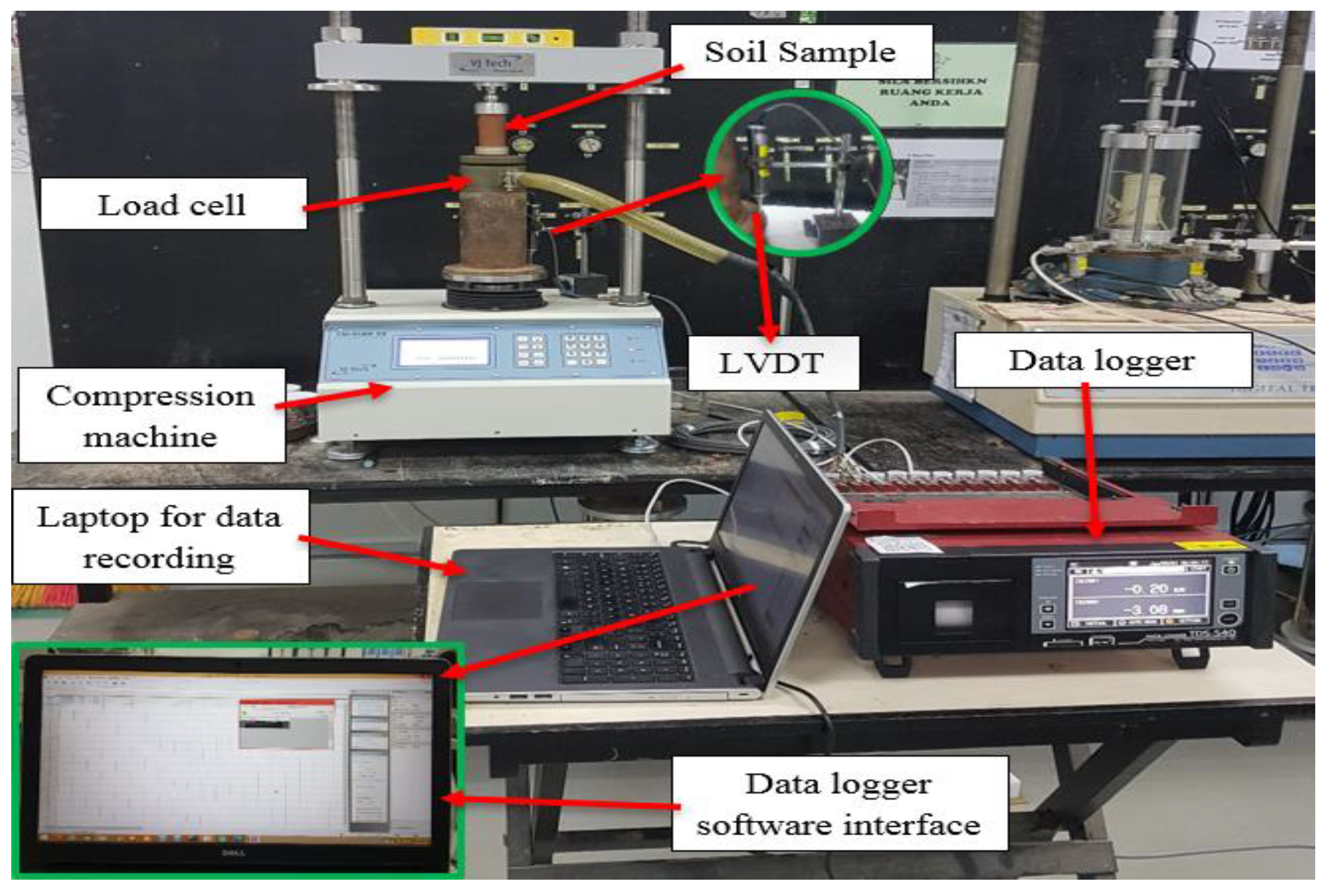


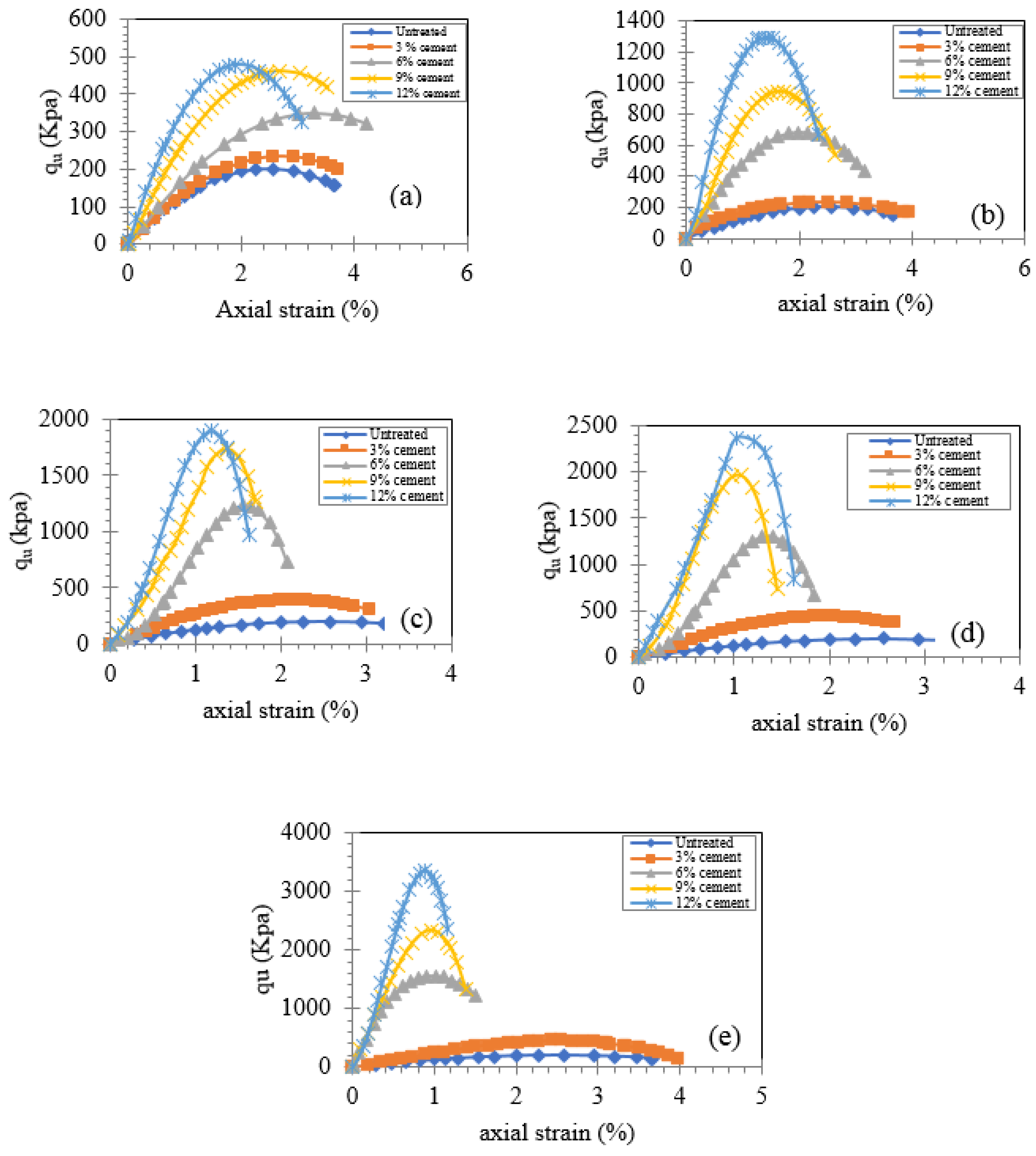
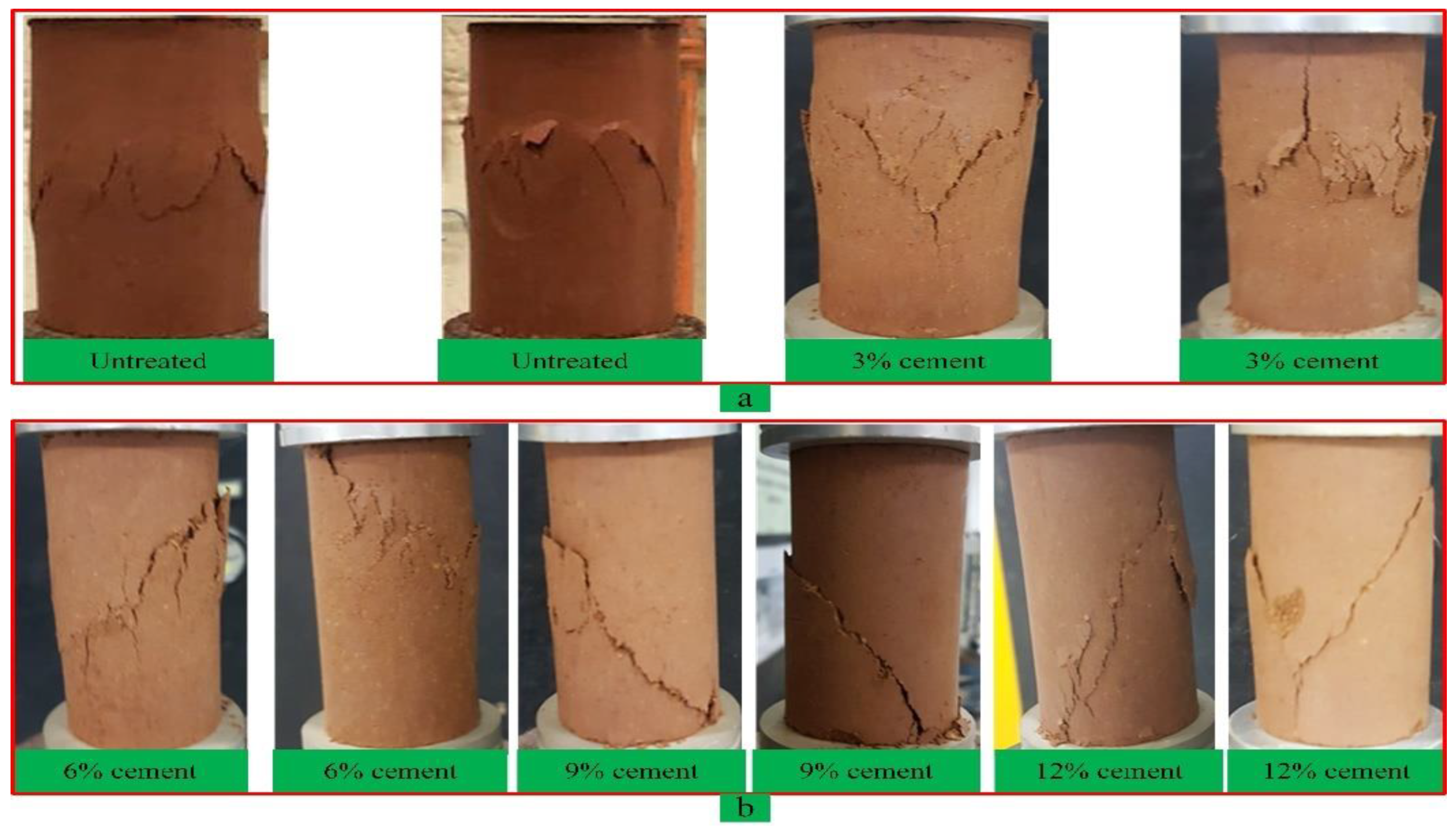

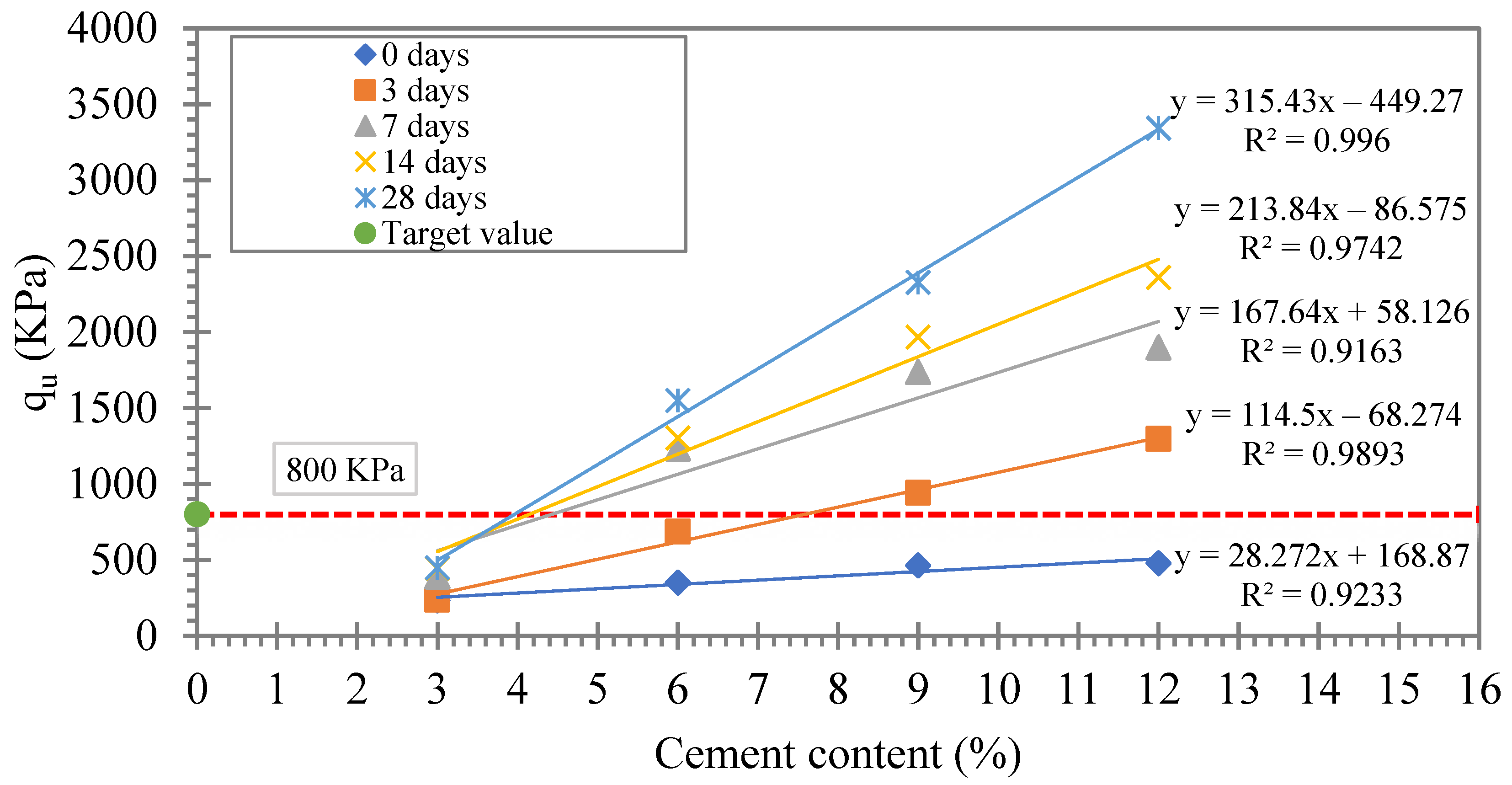

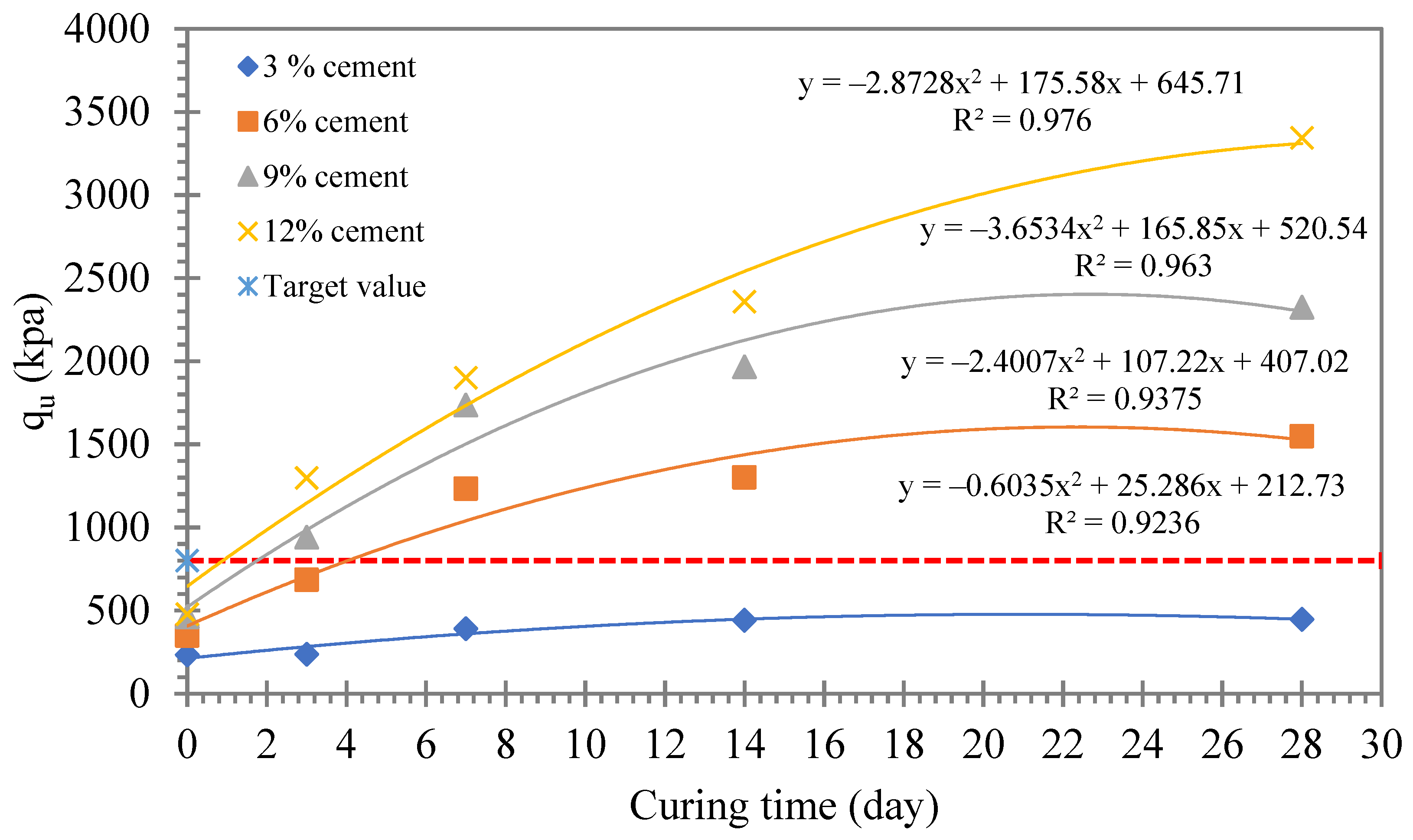
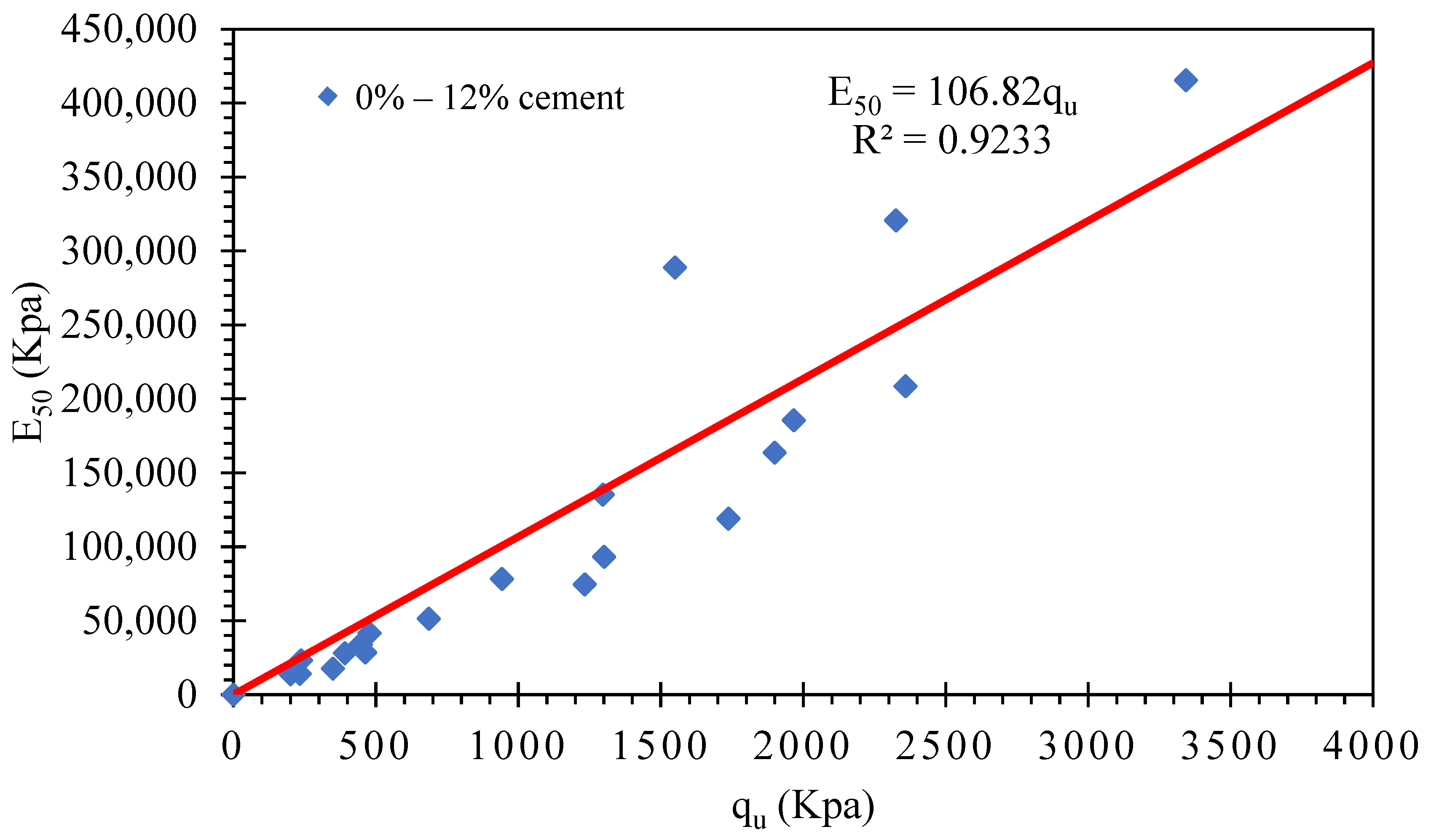
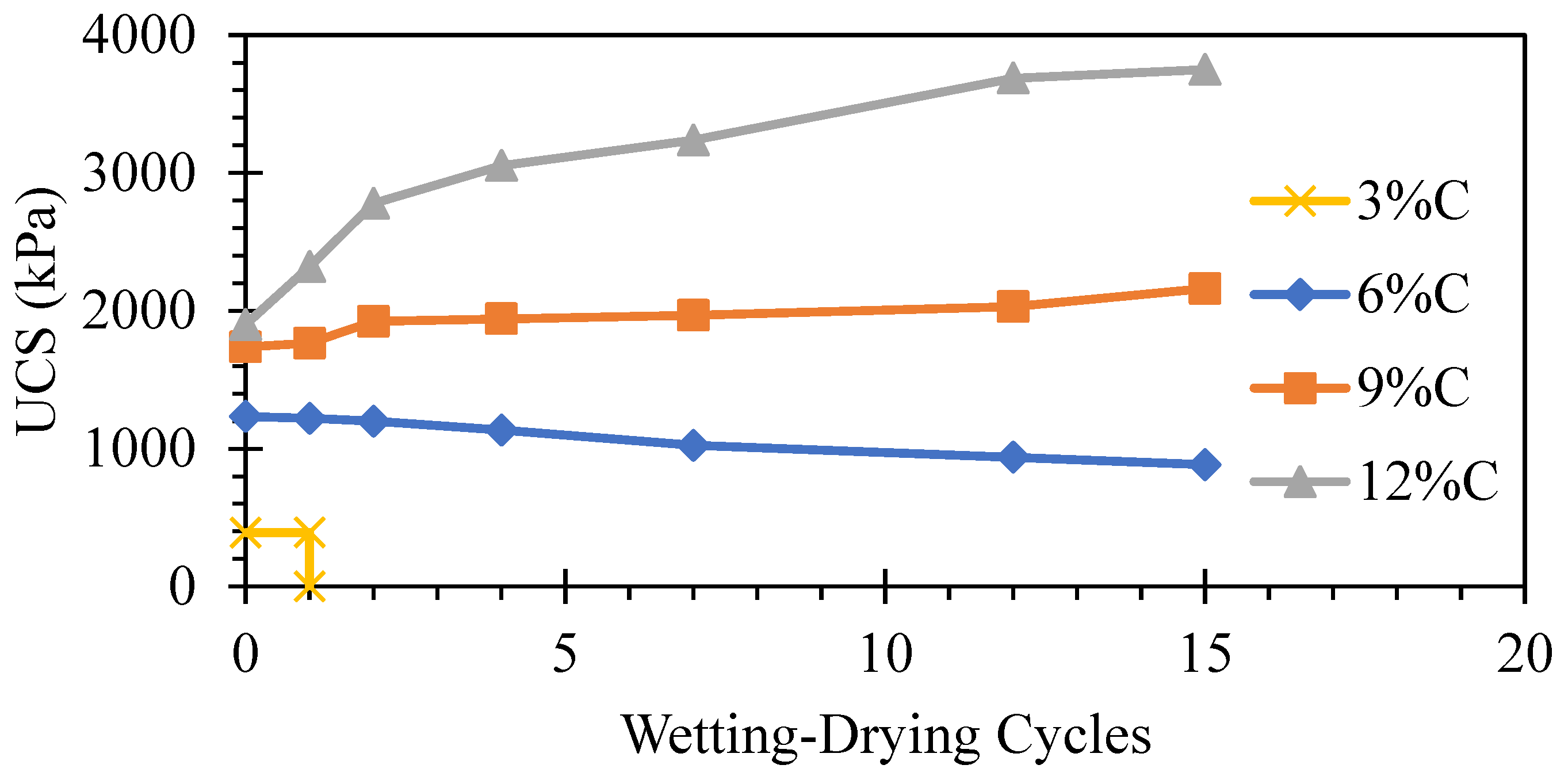



| Properties | Symbol | Value |
|---|---|---|
| Liquid limit % | 70.3 | |
| Plastic limit % | 42 | |
| Plasticity index % | 28.3 | |
| Gravel % | - | 12.79 |
| Sand % | - | 17.54 |
| Silt % | - | 61.26 |
| Clay % | - | 8.41 |
| Soil classification: | ||
| USCS | MH | |
| AASHTO | A-7-5 | |
| Optimum moisture content: % | OMC | 28 |
| Maximum dry density: | MDD | 1.39 |
| Specific gravity | 2.74 | |
| Dry unit weight: | 13.64 | |
| Unconfined compressive strength (UCS) kPa | qu | 200.75 |
| Undrained shear strength: kPa | Su | 100.38 |
| Element | Untreated | Cement |
|---|---|---|
| Wt (%) | Wt (%) | |
| O | 61.4 | 44.6 |
| Al | 16.9 | 2.5 |
| Si | 16.1 | 4.6 |
| Fe | 5.2 | 2.8 |
| K | 0.4 | 1.6 |
| Ca | - | 34.4 |
| S | - | 8.5 |
| Mg | - | 1 |
| No | Cement (%) | Curing Time (day) |
|---|---|---|
| 1 | 0 | 0 |
| 2 | 3 | 0, 3, 7, 14, 28 |
| 3 | 6 | 0, 3, 7, 14, 28 |
| 4 | 9 | 0, 3, 7, 14, 28 |
| 5 | 12 | 0, 3, 7, 14, 28 |
| Material | Stiffness, According to UCS | Reference |
|---|---|---|
| Cement-treated (3–12%) lateritic soil in Malaysia | E50 = 106.82 qu | Current study |
| Cement-treated (7–13%) silt, silty clay, and laterite in Malaysia | E50 = (100–326) qu | [2] |
| Cement-treated (1–7%) sandy clayey silt in Sweden | E50 = (16–85) qu | [82] |
| Cement-admixed (5–20%) Bangkok clay in Thailand | E50 = 150 qu | [102] |
| Cement-stabilized (10%) and cement kiln dust-stabilized (10–13%) high-plasticity soft Bangkok clay in Thailand | E50 = 113 qu | [103] |
| Cement-stabilized (10–20%) marine clay in China | E50 = (150–275) qu | [104] |
| Cement-treated (3–9%) laterite soil in Cameroon | E = 117.39 qu − 36.812 | [86] |
| Sample | Count | Total Area (µm2) | Average Size (µm) | Area (%) | Mean (µm) | Perimeter (µm) | Circularity |
|---|---|---|---|---|---|---|---|
| Ordinary Portland cement | 138 | 0.216 | 0.002 | 1.41 | 254.687 | 0.127 | 0.796 |
| Untreated | 168 | 3.021 | 0.018 | 19.713 | 254.754 | 0.374 | 0.778 |
| Cement-treated lateritic | |||||||
| 3% | 1884 | 2.196 | 0.001 | 17.894 | 254.642 | 0.103 | 0.812 |
| 6% | 1414 | 2.031 | 0.001 | 13.348 | 254.646 | 0.127 | 0.779 |
| 9% | 953 | 1.228 | 0.001 | 8.009 | 254.854 | 0.126 | 0.738 |
| 12% | 1402 | 0.813 | 0.00058 | 6.626 | 254.891 | 0.081 | 0.807 |
Publisher’s Note: MDPI stays neutral with regard to jurisdictional claims in published maps and institutional affiliations. |
© 2021 by the authors. Licensee MDPI, Basel, Switzerland. This article is an open access article distributed under the terms and conditions of the Creative Commons Attribution (CC BY) license (https://creativecommons.org/licenses/by/4.0/).
Share and Cite
Wahab, N.A.; Roshan, M.J.; Rashid, A.S.A.; Hezmi, M.A.; Jusoh, S.N.; Nik Norsyahariati, N.D.; Tamassoki, S. Strength and Durability of Cement-Treated Lateritic Soil. Sustainability 2021, 13, 6430. https://doi.org/10.3390/su13116430
Wahab NA, Roshan MJ, Rashid ASA, Hezmi MA, Jusoh SN, Nik Norsyahariati ND, Tamassoki S. Strength and Durability of Cement-Treated Lateritic Soil. Sustainability. 2021; 13(11):6430. https://doi.org/10.3390/su13116430
Chicago/Turabian StyleWahab, Norshakila Abdul, Mohammad Jawed Roshan, Ahmad Safuan A. Rashid, Muhammad Azril Hezmi, Siti Norafida Jusoh, Nik Daud Nik Norsyahariati, and Sakina Tamassoki. 2021. "Strength and Durability of Cement-Treated Lateritic Soil" Sustainability 13, no. 11: 6430. https://doi.org/10.3390/su13116430
APA StyleWahab, N. A., Roshan, M. J., Rashid, A. S. A., Hezmi, M. A., Jusoh, S. N., Nik Norsyahariati, N. D., & Tamassoki, S. (2021). Strength and Durability of Cement-Treated Lateritic Soil. Sustainability, 13(11), 6430. https://doi.org/10.3390/su13116430









